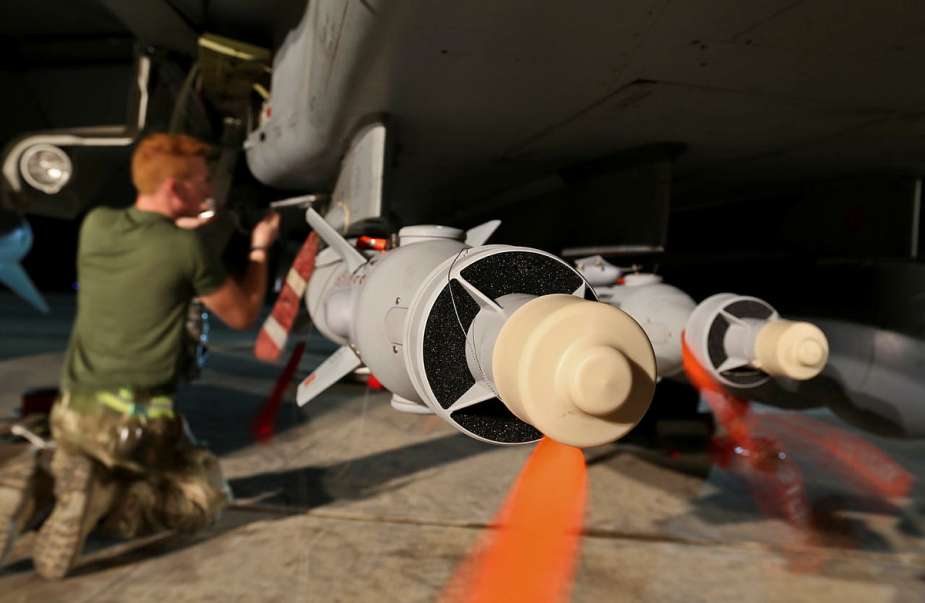US-UK joint strike targets Houthi forces with Tomahawk missiles and Paveway IV bombs
As reported by CNN on January 12, 2024, United States and British forces conducted a joint military operation against Iran-backed Houthi rebels in Yemen. This operation was initiated in response to the rebels' attacks on commercial ships in the Red Sea and was carried out as a nighttime mission. The operation incorporated a range of weapon systems, such as Tomahawk missiles and Paveway IV bombs.
Follow Army Recognition on Google News at this link

US and British forces conducted a joint military operation against Iran-backed Houthi rebels in Yemen, using various weapon systems, such as Tomahawk missiles and Paveway IV bombs. (Picture source: US and UK MoD)
The United States employed Tomahawk Land Attack Missiles (TLAMs) in this operation. These missiles, which have been in use since 1991, starting with Operation Desert Storm, are designed for long-distance strikes with a 1,000-pound warhead. They fly at subsonic speeds and have GPS guidance systems, enabling them to follow evasive routes and bypass air defenses. The Tomahawks are equipped with cameras that provide battle damage information to commanders.
The USS Florida, a nuclear-powered guided-missile submarine of the U.S. Navy, was also a part of the operation. Converted from an Ohio-class ballistic missile submarine between 2005 and 2007, the USS Florida can carry 154 Tomahawk cruise missiles. In March 2011, the USS Florida showcased its firepower by launching nearly 100 Tomahawks during Operation Odyssey Dawn in Libya.
Apart from the USS Florida, the US surface fleet deployed Arleigh Burke-class guided-missile destroyers. These destroyers, numbering almost 70 in the US Navy, serve as the backbone of the surface fleet. With a displacement of up to 9,700 tons, they carry an array of armaments, including Tomahawk cruise missiles in their Vertical Launching System (VLS). Each destroyer can carry 90 to 96 VLS cells, depending on its build date. While the Pentagon did not specify which destroyers were involved in the operation, several of them have been patrolling the Red Sea in recent months, defending commercial vessels against Houthi drone and missile attacks.
The Tomahawk missile, officially designated as the BGM-109 Tomahawk, is a cruise missile system used by the United States Navy and the Royal Navy for various mission profiles, including land-attack, anti-ship, and submarine-launched missions. Developed by General Dynamics in the 1970s, it was created to fulfill the need for a medium- to long-range, low-altitude cruise missile with modular capabilities, enabling it to carry different types of warheads, including high-explosive, submunitions, and bunker-busters.
The Tomahawk missile is powered by a Williams International F107-WR-402 turbofan engine and features a solid-fuel rocket booster for launch. It operates at subsonic speeds, approximately Mach 0.74, or around 567.7 mph, and its operational range varies among variants, with some models capable of traveling over 1,000 miles.
Various guidance systems are employed by the Tomahawk, including GPS, inertial navigation, terrain contour matching, and Digital Scene Matching Area Correlation (DSMAC) for precision targeting. It can be launched from various platforms, such as Mark 41 Vertical Launching Systems (VLS), torpedo tubes, surface ships, submarines, and Transporter Erector Launchers (TELs).
The Tomahawk missile system has undergone multiple upgrades over time, including the Block IV and Block V series, aimed at improving capabilities, navigation, and dynamic targeting. Some versions have been retired, while others have seen improvements in range, accuracy, and loitering capabilities. Ongoing research explores the potential for a supersonic Tomahawk variant with a ramjet engine, although challenges remain due to launch tube dimensions.

Royal Air Force Typhoon fighter jets were involved in the joint operation, equipped with Paveway IV laser-guided bombs. (Picture source: UK MoD)
From the British military, Royal Air Force Typhoon fighter jets were involved in the operation. These jets can reach speeds of Mach 1.8 and altitudes up to 55,000 feet. They are multirole fighters and were equipped with Paveway IV munitions for this operation. These 500-pound bombs are guided to their targets using laser marking or GPS coordinates. The Typhoons were supported by Voyager air refueling tankers.
The Paveway IV is a guided bomb developed by Raytheon UK in the early 2000s for the United Kingdom's military. It has been in service since 2008 and is designed to provide precision strike capabilities for different operational scenarios.
This guided bomb is an upgraded version of the Enhanced Paveway II guidance set and is based on a modified Mk 82 500 lbs general-purpose bomb, which has been adjusted to improve penetration. It features a guidance system in the nose section and control surfaces in the tail section, aiming to approximate the performance of the BLU-109 penetrator warhead, which is much heavier, with a similar-sized body.
The Paveway IV's guidance system offers multiple modes, including inertial navigation, GPS guidance, and semi-active laser homing, allowing for precise targeting in various conditions. It is compatible with various aircraft, including the Eurofighter Typhoon, Panavia Tornado, BAe Harrier II, and F-35 Lightning II. Currently, it is used by the United Kingdom and has also been exported to Saudi Arabia.
Technical specifications for the Paveway IV include a length of 3.1 meters, a diameter of 0.27 meters, and a wingspan of 0.42 meters with wings folded. Its weight, excluding the guidance kit, is 225 kg. The warhead is a Mk 82 Enhanced general-purpose bomb with a weight of 225 kg and a selectable height of burst feature. The bomb has a maximum range of over 30 kilometers, depending on factors such as drop altitude, speed, and flight path. It operates at subsonic speeds, making it suitable for precision strikes in various operational conditions.
- Hits: 2374
















